I built his circuit from parts in my junk box. Transistors are general purpose. Not sure what this mic is. I have no clue what the amplification factor is.
I need something smaller with less parts easier to build. Which IC makes the best amplifier?
I tried this mic on my frequency meter it does not work without an amp. I am using the mic to pick up frequency from a piano. I hit the keys the mic picks up the sound and my frequency meter tells me the frequency of that key. If the strings are out of tune I can turn the adjustment and the meter tells me when it is in tune. Then I move to a different key. It works excellent.
I have searched ebay for an hour looking for a small PC board solder on mic but nothing comes up. What is the correct name for these small mics? What is the best mic to buy?
I need a good one IC amp and a good mic?

I need something smaller with less parts easier to build. Which IC makes the best amplifier?
I tried this mic on my frequency meter it does not work without an amp. I am using the mic to pick up frequency from a piano. I hit the keys the mic picks up the sound and my frequency meter tells me the frequency of that key. If the strings are out of tune I can turn the adjustment and the meter tells me when it is in tune. Then I move to a different key. It works excellent.
I have searched ebay for an hour looking for a small PC board solder on mic but nothing comes up. What is the correct name for these small mics? What is the best mic to buy?
I need a good one IC amp and a good mic?



